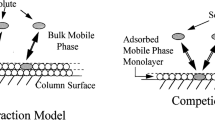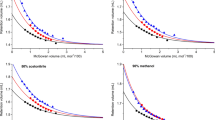Summary
Charge-transfer interactions are often assumed to be dominant among the noncovalent interactions that govern the solute retention in electron donor-acceptor chromatography. This popular view, however, has been called into question by recent studies that suggest an important role for electrostatic interactions in the formation of donor-acceptor complexes. We reported here an experimental investigation concerning the question as to whether charge-transfer or electrostatic interactions are the driving force for solute retention in donor-acceptor chromatography. Using three chromatographic systems composed of a dinitrobenzene derived stationary phase and a hexane based mobile phase, we determined retention factors for a range of aliphatic and aromatic hydrocarbons and correlated them with molecular properties that describe the solute's dispersion, charge-transfer, and electrostatic characteristics. It was found that the molecular polarizability and ionization potential give either very poor or no correlation with solute retention whereas the molecular quadrupole moment is a linear function of the logarithmic retention factor. These results were interpreted as showing that electrostatic, rather than charge-transfer or dispersion, interactions play a major role in determining solute retention. The dominance of the electrostatic interactions over the other noncovalent interactions was discussed in terms of distance dependency of the interaction energy.
Similar content being viewed by others

References
X. P. Yan, Y. W. Wu, Y. L. Sun, J. Chromatogr. A724, 337 (1996).
G. Felix, A. Thienpont, P. Dentraygues, Chromatographia34, 177 (1992).
D. M. Cox, S. Behal, M. Disko, S.M. Gorun, M. Greaney, C. S. Hus, E. B. Kollin, J. Millar, J. Robbins, R. D. Sherwood, P. Tindall, J. Am. Chem. Soc.113, 2940 (1991).
K. Yamamoto, H. Funasaka, T. Takabshi, T. Akasaka, J. Phys. Chem.98, 2008 (1994).
K. Kimata, T. Hirose, K. Moriuchi, K. Hosoya, T. Araki, N. Tanaka, Anal. Chem.67, 2556 (1995).
D. Fuchs, H. Reitschel, R. H. Michel, A. Fischer, P. Weis, M. M. Kappers, J. Phys. Chem.100, 725 (1996).
G. Felix, C. Bertrand, JRC & CC7, 160 (1984).
L. Nondek, R. Ponec, J. Chromatogr.294, 175 (1984).
L. Nondek, J. Chromatogr.373, 61 (1986).
M. R. Battaglia, A. D. Buckingham, J. H. Williams, Chem. Phys. Letters78, 421 (1981).
A. Chablo, D. W. J. Cruickshank, A. Hinchliffe, R. W. Munn, Chem. Phys. Letters78, 425 (1981).
S. L. Price, Chem. Phys. Letters114, 359 (1985).
J. Hernandez-Trujillo, A. Vela, J. Phys. Chem.100, 6524 (1996).
L. Nondek, M. Minarik, J. Chromatogr.324, 261 (1985).
K. J. Miller, J. A. Savchik, J. Am. Chem. Soc.101, 7206 (1979).
D. R. Lide, Editor-in-Chief, “CRC Handbook of Chemistry and Physics”, 73rd Edn., CRC Press, Boca Raton, 1992.
M. Rigby, E. B. Smith, W. A. Wakeham, G. C. Maitland, “The Forces between Molecules”, Clarendon, Oxford, 1986.
Q.-H. Wan, L. Ramaley, R. Guy, Anal. Chem.69, 4581 (1997).
R. Foster, “Organic Charge-Transfer Complexes”, Academic Press, London and New York, 1969.
K. Morokuma, Acc. Chem. Res.10, 294 (1977).
F. Cozzi, M. Cinquini, R. Annuziata, J. S. Siegel, J. Am. Chem. Soc.115, 5330 (1993).
N. M. Brown, F. Swinton, J. Chem. Soc. Chem. Comm. 770 (1974).
A. W. Schwabacher, S. Zhang, W. Davy, J. Am. Chem. Soc.115, 6995 (1993).
Q.-H. Wan, L. Ramaley, R. Guy, Chromatographia46, 495 (1997).
C. A. Hunter, J. Mol. Biol.230, 1025 (1993).
D. A. Dougherty, Science271, 163 (1996).
M. Luhmer, K. Bartik, A. Dejaegere, P. Bovy, J. Reisse, Bull. Soc. Chim. Fr.131, 603 (1994).
J. H. Williams, Acc. Chem. Res.26, 593 (1993).
Author information
Authors and Affiliations
Additional information
Dedicated to Professor John H. Knox on the occasion of his 70th birthday.
Rights and permissions
About this article
Cite this article
Wan, Q.H., Ramaley, L. & Guy, R. The driving force for solute retention in electron donor-acceptor chromatography: Electrostatic versus charge-transfer interactions. Chromatographia 48, 523–528 (1998). https://doi.org/10.1007/BF02466644
Received:
Revised:
Accepted:
Issue Date:
DOI: https://doi.org/10.1007/BF02466644



